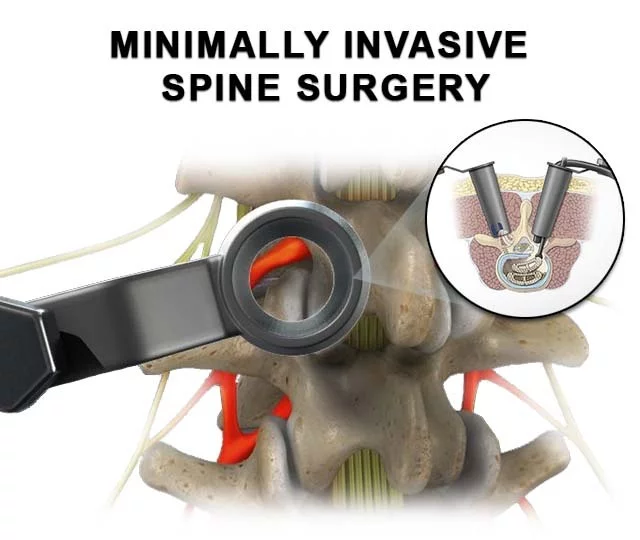Treatment
Minimally invasive Spine Surgery
Minimally invasive spinal surgery (MISS) is a type of back surgery performed through small incisions. This less invasive type of spinal procedure is done with a specialized hollow tube known as a tubular retractor. The spine surgeon uses this tool to visualize and treat the targeted spine area. This results in less trauma being caused to the nearby muscles and surrounding tissue.
When the tube-shaped tool is inserted into the small incision, it gently pushes aside the muscle and soft tissue, creating a tunnel to the problem area of the spine. This enables the spine surgeon to insert small tools through the retractor and work on your spine. During the entire minimally invasive spine surgery, a special operating X-ray is used (fluoroscopy) that provides the doctor with real-time images of your spine.
This less invasive back surgery technique gives your surgeon great precision to repair and treat the targeted area. Another advantage it has over standard surgery is less pain and faster recovery times after surgery. MISS can be used for various types of spine surgery.

Spinal Injection
Spinal injections reduce back pain and restore functionality to your back. Multiple spinal conditions can cause debilitating back pain, which limits what you can do. The best pain management in Hurst Texas use spinal injections after a careful examination of your back pain problem.
The spine injections work by:
- Reducing inflammation by easing pinched nerves caused by herniated discs
- Suppressing spontaneous nerve signals from an irritated nerve
- Blocking signals between the nerve cells and your brain
- Reducing pain through the pain-relieving medication in the injection

Nerve Block Injection
A nerve block injection, administered by the sure hands of the top back pain specialist in Hurst Texas, can deaden your pain as soon as it’s injected. That reaction is due to a local anesthetic that’s contained in the injection, which starts working as soon as your pain doctor injects the medicine in the area where your pain originates.
Before giving you the nerve block injection, your doctor has to be reasonably sure the targeted area is where your pain is coming from. That determination is not as easy as you may suppose, since pain in your body has a tendency to radiate to other areas. Leg or foot pain, for example, may originate in your lower back or your pelvis.

Ketamine
Ketamine is a medicinal drug that has analgesic or pain-numbing properties. Ketamine therapy is a convenient and fast way to get relief from chronic pain. Sometimes, your chronic pain can cause psychological problems or vice versa. These psychological conditions also benefit from the ketamine infusion therapy because ketamine works well as an anti-depressant.
The FDA classifies ketamine as an anesthetic induction agent. That means it’s meant to be administered intravenously for anesthetic pain relief. Today, ketamine has become one of the best pain management methodologies, especially for chronic pain syndromes that have a neuropathic component.

Joint Injections
Some common joint injections include:
- Steroid injections. These injections contain a corticosteroid medication and a local anesthetic to relieve pain and reduce inflammation. Your doctor injects the medication right into the joint.
- Trigger point injections. Targeting trigger points in your joints, these injections relax muscle tension, inflammation, muscle trauma and an acute injury.
- Platelet-rich plasma injections. PRP injections contain a concentration of platelets from your own blood. Platelets have beneficial properties that speed up the healing of injured tissues, including tendons, ligaments and muscles.
- Nerve blocks. These injections deaden the affected nerve in your joint, keeping it from sending pain signals to your brain. While these injections don’t address the source of the pain, they allow you to move forward with other treatment without pain.

